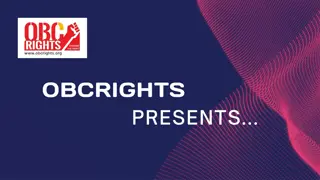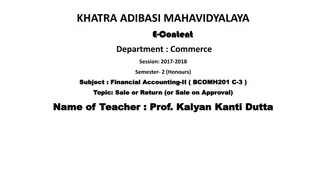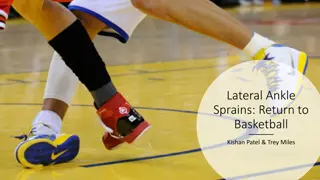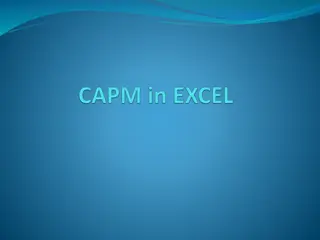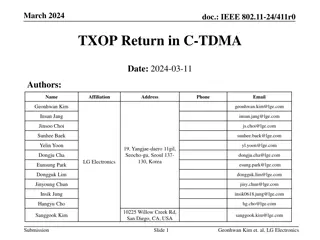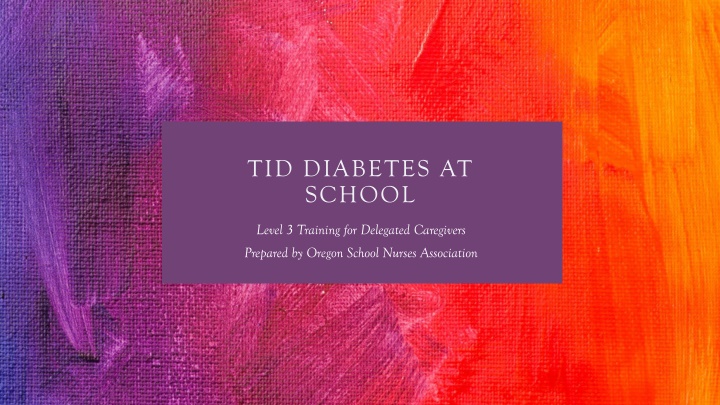
Return of the Old Library Recommendations
The Return of the Old Library Recommendations and Considerations Group 3 aims to restore the old library to its former glory, repurpose the building for modern needs, increase collaboration with university departments, and preserve Gondourian heritage and identity. The methodology involves aligning with the university's vision, environmental scanning of big universities, gathering feedback through surveys, and user-driven design. The vision is to create a greater sense of community, improve student quality of life, and foster growth and unity. Recommendations include focusing on Gondourian history, culture, art, design, and architecture in the new library, with a permanent digital exhibit and research lab.
Download Presentation

Please find below an Image/Link to download the presentation.
The content on the website is provided AS IS for your information and personal use only. It may not be sold, licensed, or shared on other websites without obtaining consent from the author. If you encounter any issues during the download, it is possible that the publisher has removed the file from their server.
You are allowed to download the files provided on this website for personal or commercial use, subject to the condition that they are used lawfully. All files are the property of their respective owners.
The content on the website is provided AS IS for your information and personal use only. It may not be sold, licensed, or shared on other websites without obtaining consent from the author.
E N D
Presentation Transcript
TID DIABETES AT SCHOOL Level 3 Training for Delegated Caregivers Prepared by Oregon School Nurses Association
DISCLAIMER Oregon School Nurses Association's educational material and/or language are intended as examples that may serve as a tool for those responsible for drafting and carrying out educational content that meet the needs of a local school or district. These examples are not authoritarian, nor should they be viewed as complying with any requirements specific or unique to any school or district or state laws. Educational resources and language should not substitute or replace the advice of legal counsel and/or research on applicable federal or local laws, regulations or ordinances.
TO PROVIDE A FOUNDATION FOR STUDENT SPECIFIC TRAINING FOR UAPS THAT WILL PRACTICE DIRECT STUDENT CARE. TO UNDERSTAND THE SCOPE OF PRACTICE OF A UAP AND SCOPE OF DELEGATION PURPOSE TO ENSURE COMPETENCY AMONG DELEGATED CAREGIVERS TO IDENTIFY DAILY MANAGEMENT NEEDS OF STUDENTS WITH T1D
PREREQUISITES AND POST REQUISITES Prerequisites Post-requisites Level 1 Diabetes Education Level 2 Diabetes Education Hands on skills training Individualized health plan training
DELEGATED CAREGIVER TRAINING Level 3 Training
Understand Understand daily diabetes care Describe Describe the steps to responding to diabetes related emergencies Apply Apply appropriate UAP scope of practice LEVEL THREE OBJECTIVES Utilize Utilize the process and rational for monitoring blood glucose levels Identify Identify the steps to counting carbohydrate Explain Explain insulin dosing and administration Articulate Articulate elements of an IHP Recognize Recognize when to call the nurse
Students with T1D have multiple levels of care that requires a school community approach: Nurse UAP Counselor/504 coordinator or IEP Case Manager Building Administrator Educators Support Staff ROLES OF CAREGIVING
Created and Updates IHP Clinically Case Manages student Coordinates with family and providers Assess student and family NURSE S ROLE Trains and delegates nursing tasks when appropriate Provide expert consultation Provides student education Makes clinical decisions
Monitors for changes in the school setting Communicates changes to nurse and family Provides delegated care as per step-by- step procedures in IHP Communicates supply and medication needs to family UAP S ROLE Consults with nurse on deviations from typical care or presentation Supports student in learning goals the nurse has established Supports communication to family
Serves as member of the multidisciplinary team Case manages students 504 Accommodations COUNSELOR S ROLE May serve as a backup caregiver or emergency caregiver depending on the school environment Endorses communication to educators, family, student, and RN
Provides Participates in training to support understanding of students condtion and safety communication to RN and family on concerns, successes and deviations from norm Passively observes students for signs and symptoms of high or low blood sugar during school EDUCATOR AND SUPPORT STAFF ROLE Encourages and prompts student care when needed Applies student accommodations throughout the school day Communicates with family related to classroom events, parties, etc.
Provides support to school training and case management in the building. Works to optimize student safety and a culture of care Endorses appropriate accommodations throughout the school setting Provides an appropriate space for diabetes care in the building ADMINISTRATOR S ROLE Supports multidisciplinary team for whole childcare
IHPs maybe referred to as Individual Health Plans or Individual Health Protocols, depending on the district Plans may include and Emergency Care Plan ( ECP) or the ECP may be separate, depending on the district Diabetic Medical Management Plans ( DMMP) may be used in some districts School Diabetic Orders are the orders provided by the student's endocrinologist ( there may also be varying names) INDIVIDUAL HEALTH PLAN/PROTOCOL For the purposes of this training, we will refer to IHP and School Diabetic Orders. IHP s are nurse authored documents that are different from 504s and IEPs IHPs outline the totality of student care and procedures for UAPs, designate when to call the nurse, parent and EMS IHPs are living documents that may be updated depending on the IHPs are driven by school diabetic orders and nursing assessment
BLOOD GLUCOSE MONITORING
BLOOD GLUCOSE MONITORING Primary methods include glucometer or continuous glucose monitors ( CGM) Critical element of overall glycemic control Used in day-to-day treatment decisions
Students who check by capillary blood glucose (CBG) monitor or glucometer will require scheduled testing Students must check blood sugar often, especially when newly diagnosed, young or unstable CHECKING BLOOD GLUCOSE Students with CGM s will have devices, such as cell phones that transmit blood glucose information Students who are not independent will require trained staff to assist in monitoring.
CONTINUOUS GLUCOSE MONITOR (CGM) Compact device Continuously measures interstitial glucose Connected to body by cannula with a sensor Sensor sends blood glucose date to a wireless device to display on a smartphone app. Measures blood glucose consistently and has parameters to alarm of trends up or down. Some CGM s are approved for treatment decisions, some are not.
CAPILLARY BLOOD GLUCOSE (CBG) MONITOR Uses a lancet to prick finger Blood is dropped onto test strip Measures capillary blood glucose level
TARGET RANGE The target range is the blood glucose range assigned by the provider that the student aims to stay between. Low is often between 80 mg/dL and 100 mg/dL and high between 200 mg/dL and 300 mg/dL
GLYCEMIC CONTROL Delicate balancing act of maintaining blood glucose in the target range. Average blood glucose levels over time ( hemoglobin A1c) Short term consequences to poor glycemic control may be emergent or impact academic access Long term consequences result in poor health outcomes
INSULIN Insulin, Delivery & Dosing
INSULIN DOSING & ADMINISTRATION Insulin is adminsitrered in two primary formulas: Insulin may be administered in a variety of ways: Carbohydrate Cover Dose High Glucose Correction Dose Vial and syringe Pen Pump
CARBOHYDRATE COVER DOSE Ratio of insulin prescribed by physician to cover the carbohydrates consumed in grams Individualized ratios/sliding scales.
CARBOHYDRATE COVER DOSE Carbohydrates Insulin Units <2 0 3-8 .5 9-14 1 15-20 1.5 Carbohydrate covers are prescribed at mealtime. 21-26 2 27-32 2.5 33-38 3.0 Example order: 1 unit of insulin per 12 grams of carbohydrates consumed at lunch. 39-44 3.5 45-50 4 51-56 4.5 57-62 5 63-68 5.5 Divide the total number of carbohydrates by twelve ( and round to the nearest , 5 units, unless otherwise indicated) 69-74 6 75-80 6.5 81-86 7 87-91 7.5 92-98 8 99-103 8.5 104-110 9 111-116 9.5
Identify carbohydrate content in each food item Nutrition labels Nutrition applications Nutrition facts from school lunch program List all carbohydrate numbers in grams for all items to be consumed in meal Add numbers together for total carbohydrate count HOW TO COUNT CARBOHYDRATES
HIGH SUGAR CORRECTION Blood Glucose Insulin Units 150-200 0.5 Example Order: 0.5 units of insulin for every 50 mg/dL over 150 mg/dL . Sliding Scale for blood glucose over: >150 mg/dL 201-250 1 251-300 1.5 301-350 2 351-400 2.5 401-450 3 451-500 3.5 501-550 4.0 551-600 4.5 5.0 600 /HIGH
Identify units of insulin for BG level ( Correction dose) Note: Identify when last correction dose was given, if within past 3 hrs. Correction dose may be contraindicated, defer to School Diabetic Orders/IHP Determine blood glucose level INSULIN DOSING Identify Total Carbohydrate Count of meal to be consumed Determine insulin dose for carbohydrate cover Add cover dose and correction dose Double check dosing prior to administration
Insulin is administered under the circumstances that the physician prescribes. This may include before meals and snacks, or just meals. This may include for high blood glucose correction WHEN TO ADMINISTER INSULIN Doctor s orders must be followed to determine when to administer insulin and how much. There nurse will create an individualized plan that explains these processes for unlicensed staff. The nurse may choose to hold insulin when a blood glucose is low.
HOW TO ADMINISTER INSULIN Insulin is administered either by injection or infusion This is most commonly via insulin pen or insulin pump Some students may have insulin vials and syringes IV insulin is never administered at school Each for of insulin administration requires specific training and delegation, where permissible
INSULIN PEN Insulin pens have a replaceable cartridge containing insulin Drawing up insulin is not necessary Insulin doses are dialed to be injected Units are visible through a window on the pen. Insulin is injected subcutaneously Insulin pen must be primed prior to use Skill requires hands on learning with return demontration
INSULIN PUMP Small computerized device Delivers basal dose Delivers bolus dose Many different pumps-Manufacturer direction specific Some work with CGM s directly through wireless connection
Some students will have insulin that is in vials that must be drawn up at each use This is a specific skill that requires one-on-one training and demonstration Insulin is drawn up with a syringe from a vial at each administration Syringes are single use, vial is multiple use
DOCUMENTATION Documentation is a critical element of student diabetes management There are a variety of ways to apply documentation ( paper, electronic, EHR) Student blood glucose and insulin need to be documented Deviations and treatment for highs and lows should also be documented
HIGH AND LOW BLOOD GUCOSE
HYPERGLYCEMIA REVIEW Hyperglycemia Blood glucose above target range Refer to IHP Interventions may include: Reduced activity Increased fluid intake Testing ketones Risks may include: Illness Stress Injury Symptoms Frequent urination Increased thirst Blurred vision Headache Fatigue Warm Skin Mood Changes Fruity smelling breath Nausea and Vomiting Dry Mouth Weakness Confusion Coma Abdominal Pain Rapid shallow breathing
TESTING KETONES Ketones are tested as prescribed by the provider Often for sustained highs Done by urine dipstick or finger stick similar to a blood glucose monitor Presence of ketones warrants a call to nurse/family, follow IHP Procedure requires hands on education with return demonstration
HYPOGLYCEMIA REVIEW Risk Factors Causes Higher insulin requirements Insulin pen or injectable insulin regimen Poor glycemic control History of frequent hypoglycemia Multiple insulin regimens Too much insulin More exercise than typical Not enough food intake
Shakiness Dizziness Sweating Rapid heart rate Difficulty concentrating EARLY Hunger SYMPTOMS OF HYPOGLYCEMIA Confusion Irritability Anxiety Headache Weakness Pallor
Clumsiness Inability to eat or drink Muscle weakness MODERATE TO SEVERE HYPOGLYCEMIA Difficulty speaking Blurry vision Drowsiness Confusion
Seizure Change in level of consciousness SEVERE HYPOGLYCEMIA Death
Provide Provide 15 grams fast acting sugar Do not move Do not move student ( walking can further decrease blood glucose) Check Check blood glucose after 15 minutes If not in target range, provide additional 15 grams of fast acting sugar, continue to monitor student Provide TREATING MILD TO MODERATE HYPOGLYCEMIA Recheck Recheck blood glucose in 15 minutes If blood glucose remains low, provide another 15 grams of fast acting sugar, call parent and RN Provide If blood glucose continues to decline, or does not improve with 3 treatments ( or as designated by MD) prepare to administer glucagon, and/or call EMS (9-1-1) Prepare Give a complex carbohydrate or protein when blood glucose is within target range provide to sustain BG Give
Severe hypoglycemia is an emergency Act Immediately Stay with student TREATING SEVERE HYPOGLYCEMIA Place student in recovery position Call 911 Prepare to administer Glucagon
GLUCAGON Refer to Emergency Caregiver ( Level 2 Training) Refer to Oregon Protocol for Glucagon Providers
Communication is a hallmark of whole child care at school, this includes: Internal communication with staff External communication with family SCHOOL COMMUNICATION Critical communication: When supplies are needed or expired When there will be a change in daily schedule or activity When there will be a party of field trip When there are changes to the student's compliance, stability or care or affect
Outside of Target Range Sustained hyper or hypoglycemia Frequent lows WHEN TO CALL THE NURSE Frequent highs Pump failure Missing/expired medication Frequent absences Symptoms not reflective of blood glucose level
DISCLAIMER This is sample material for training for diabetic emergencies A student's provider dictates students treatment regimen including emergency mediations State laws govern the scope of practice and emergency training for unlicensed assistive personnel at school Each nurse is responsible to identify their own state requitements State laws are specific on glucagon administration in the school setting Identify the processes that must occur in the school setting Identify whether or not unlicensed staff can administer glucagon Identify specific training that may be required for glucagon providers in the school setting You must follow state laws that govern scope of practice and training



